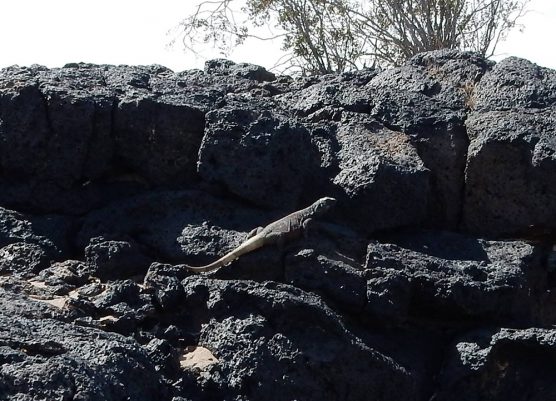 Some people who visit our desert regions for the first time encounter what they believe to be a frightening creature – a large lizard that some say looks a bit like a small alligator. That fear-inducing creature is a chuckwalla (sauromalus ater).
Some people who visit our desert regions for the first time encounter what they believe to be a frightening creature – a large lizard that some say looks a bit like a small alligator. That fear-inducing creature is a chuckwalla (sauromalus ater).
The chuckwalla is the second largest lizard in the United States, second only to the gila monster. An adult male can reach 18 inches in total length, while the female is somewhat smaller.
Chuckwallas can be found throughout most of the Mojave, Sonoran and Colorado deserts, from sea level to about 4,500 feet. They live in large rocks, boulder piles and rock outcroppings in slopes.
The chuckwalla’s scientific name derives from the Greek word “sauros,” which means lizard, and “omalus” (or “homalus”), which refers to the animal’s flat body shape. Its closest relatives are iguanas, but the chuckwalla lacks the mid-dorsal crest and therefore has a lower profile than other iguanus. The word “ater” means black. The common name (chuckwalla) comes from the Shoshone word “tcaxxwal,” which the Spanish wrote as “chacahuala.”
 Even though the chuckwalla might look mean, there is no reason to fear it. It is a herbivore – an animal that is anatomically and physiologically adapted to eating plant material. The chuckwalla eats desert flowers, fruits, creosote leaves and other desert plants and has no interest in trying to eat you.
Even though the chuckwalla might look mean, there is no reason to fear it. It is a herbivore – an animal that is anatomically and physiologically adapted to eating plant material. The chuckwalla eats desert flowers, fruits, creosote leaves and other desert plants and has no interest in trying to eat you.
Chuckwallas never drink water, even when it is readily available to them. They get all of the water they need from the plants they eat. They also do not urinate. Instead, they void body salts by passing crusty salts, which break up and fall out when the chuckwallas exhale.
Chuckwallas are active all year in warm areas, but they are most active in spring and early summer. A typical day in the life of a chuckwalla begins with basking on rocks early in the day and then foraging or engaging in social behavior. Once the day gets too hot, chuckwallas typically retreat into crevices in the rock. In mild weather, the lizards often become active again in the afternoon.
Peak foraging and breeding months are late April to early June. The average clutch size is eight eggs. Female chuckwallas may only produce one clutch in two or three years, especially if the weather conditions are not favorable.
 Due to their relatively large size, chuckwallas also have relatively large predators – coyotes, Mojave rattlesnakes, American kestrels and red-tailed hawks. However, the chuckwalla can move and leap with great speed. If threatened, it will seek refuge in a rock crevice and then inflate itself with air to wedge itself solidly into the crevice, making it almost impossible to remove it.
Due to their relatively large size, chuckwallas also have relatively large predators – coyotes, Mojave rattlesnakes, American kestrels and red-tailed hawks. However, the chuckwalla can move and leap with great speed. If threatened, it will seek refuge in a rock crevice and then inflate itself with air to wedge itself solidly into the crevice, making it almost impossible to remove it.
If you want to photograph chuckwallas, the best time is early in the day when they are sitting on rocks and basking in the sun. However, once you spook them and they run into the rocks, you could end up waiting more than an hour for them to come out and show themselves again.
So pack your camera and your patience, and don’t be afraid to get close to one if it will let you.
Linda Castro is a nature enthusiast and animal lover. She is the Desert Field Organizer for the California Wilderness Coalition and serves on the board of the SCV-based Community Hiking Club. Her commentaries relate to California’s deserts.
Like this:
Like Loading...
Related









 Tweet This
Tweet This Facebook
Facebook Digg This
Digg This Bookmark
Bookmark Stumble
Stumble RSS
RSS









































REAL NAMES ONLY: All posters must use their real individual or business name. This applies equally to Twitter account holders who use a nickname.
1 Comment
My boy and his friends had them as pets. They will draw blood like a stuff pig. Nice article..